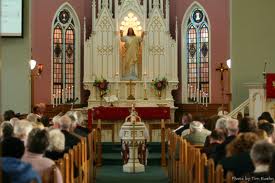A brief survey of the parts of the DIVINE SERVICE, the chief worship service among Lutherans, can be found here.

Receiving Good Things from God
St. Paul’s, Kitchener, Ontario, Canada
The Athanasian Creed teaches us that true Christian worship can be recognized in two ways. First we worship the God who is triune, that is, Father, Son, and Holy Spirit. The second way we recognize Christian worship is that it is centered on Jesus Christ, the only-begotten Son of God. Our worship is “Divine” because it is Christ-centered.
The Lutheran Confessions teach us about the “Service” of Divine Service: “The service and worship of the Gospel is to receive good things from God” (Apology, IV, 310). In the Divine Service, God, who calls, gathers, and enlightens the whole Christian church on earth, comes with His gracious gifts to serve us.
People often think that worship is about what we do for or toward God. The reality is quite different. In the Divine Service God is providing his service for us. In the reading, the preaching, and the proclamation of his Word, in his Sacraments of Holy Baptism and Holy Communion, God comes to us. The work we do in worship is to receive the gift of God’s grace and respond.
Our Lord speaks and we listen. His Word bestows what it says. Faith that is born from what is heard acknowledges the gifts received with eager thankfulness and praise. Music is drawn into the thankfulness and praise, enlarging and elevating the adoration of our gracious giver God. Saying back to him what he has said to us, we repeat what is most true and sure.
Dr. Norman Nagel
from the introduction of Lutheran Worship
[still one of the best concise descriptions
of the Divine Service, bar none]
Because of our sin, we cannot come to God, but God must come to us. This is what takes place in the Divine Service. Through the Word and Sacraments God speaks to his people. He reminds us of our sinfulness and failure to love completely and he then forgives us and assures us of the grace we have in Jesus Christ.
This grace is central to our lives as Christians and we must treat it with all reverence and respect. It was not of our doing and it is not ours with which to tamper. Therefore worship is not a matter of novelty or entertainment, much less a matter of attempting to please the masses. For this reason hymns are chosen to round out our worship that are doctrinally sound and theologically significant. Hymns, like the liturgy, must reflect this Christo-centric “God coming to man” theology or else they are unfit for the service. May our worship always be pure and always emphasize this Biblical Christo-centric attitude.
The Divine Service Tells the Story of Salvation
The structure of the Divine Service is the story of God’s work of salvation—the essence of the Bible itself. In the Divine Service, God invites us to take part in that story, to be immersed in it and find our place at the table. As we take part regularly, this story becomes our story. The Gloria begins at the beginning—the Christmas announcement of the angels—but in the process makes of us messengers bringing the news of peace on earth, reminds us that the God we worship has come in the flesh, and points forward to the Lord’s Supper that will come later. The Kyrie joins us to those lepers, the blind, the deaf, the sick, and all those who call upon the Lord for mercy and gives us the hope that as they graciously received it, so will we as we meet Christ in this service. The Readings place us within the biblical narrative at a specific time and place to hear the Word alongside its original hearers, both believers and doubters, the obedient and the disobedient. The Agnus Dei puts us alongside John the Baptizer and once again enables us to ask for mercy. The Sanctus reminds us that the Christ who is acclaimed with the Palm Sunday crowd is none other than the Messiah whom Isaiah saw high and lifted up, the one we will meet in the flesh momentarily. The Words of Institution are the purest narrative, explaining, interpreting, and offering what we have asked for all along—Kyrie eleison, Lord have mercy. The Nunc Dimittis brings the worshiper full circle to where it all began and makes of us Simeons who have held the Lord in our hands and have thus seen the promise fulfilled. We are ready to go in peace.
How Lutherans Worship—the Project
- 1: Invocation
- 2: Making the Sign of the Cross
- 3: Confession and Absolution
- 4: The Liturgy
- 5: On Liturgy . . . Some Different Perspectives
- 6: Excursus: More on Confession and Absolution
- 7: Service of the Word & Introit
- 8: Kyrie & Hymn of Praise
- 9: Excursus: Trinitarian Nature of the Lord’s Supper
- 10: Excursus: What is Lutheran Worship?
- 11: Prayer and the Collect of the Day
- 12: Hearing God’s Word
- 13: The Hymns & the Sermon
- 14: Response to the Word–The Creed and The Prayer of the Church
- 15: The Service of the Sacrament–The Preparation [Coming]
